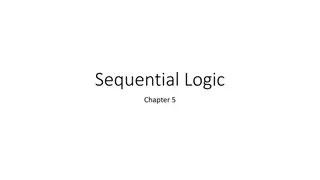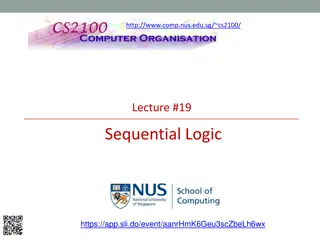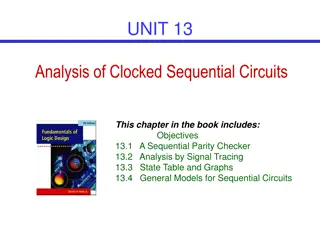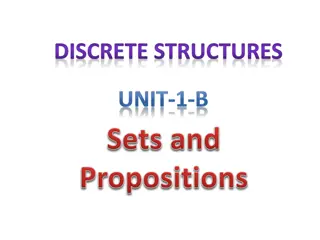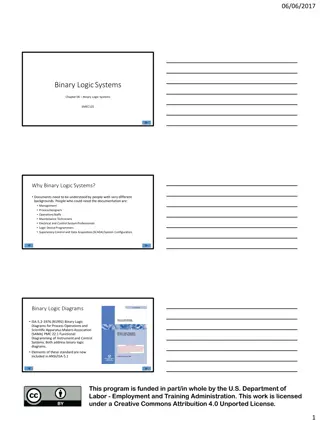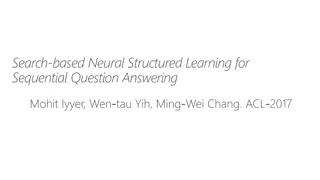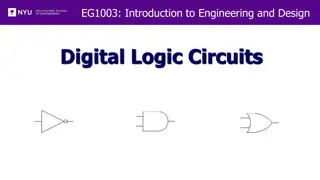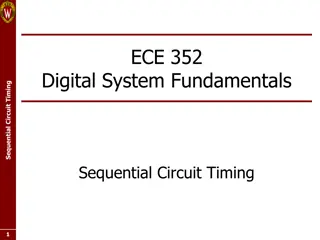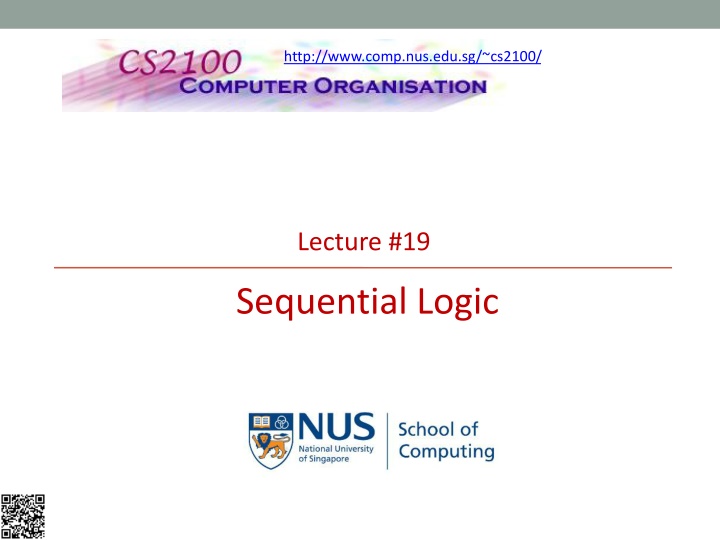
Sequential Logic for Synchronous Circuits
Explore the fundamentals of sequential logic and synchronous sequential circuits in this insightful lecture by Aaron Tan at NUS. Dive into the characteristics of flip-flops, state tables, and circuit analysis, gaining a deeper understanding of how these building blocks operate within digital systems.
Download Presentation

Please find below an Image/Link to download the presentation.
The content on the website is provided AS IS for your information and personal use only. It may not be sold, licensed, or shared on other websites without obtaining consent from the author. If you encounter any issues during the download, it is possible that the publisher has removed the file from their server.
You are allowed to download the files provided on this website for personal or commercial use, subject to the condition that they are used lawfully. All files are the property of their respective owners.
The content on the website is provided AS IS for your information and personal use only. It may not be sold, licensed, or shared on other websites without obtaining consent from the author.
E N D
Presentation Transcript
http://www.comp.nus.edu.sg/~cs2100/ Lecture #19 Sequential Logic
Questions? Ask at https://sets.netlify.app/module/676ca3a07d7f5ffc1741dc65 OR Scan and ask your questions here! (May be obscured in some slides)
Aaron Tan, NUS Lecture #19: Sequential Logic 3 6. Synchronous Sequential Circuits Building blocks: logic gates and flip-flops. Flip-flops make up the memory while the gates form one or more combinational sub-circuits. We have discussed S-R flip-flop, J-K flip-flop, D flip-flop and T flip-flop.
Aaron Tan, NUS Lecture #19: Sequential Logic 4 6.1 Flip-flop Characteristic Tables Each type of flip-flop has its own behaviour, shown by its characteristic table. S R Q(t+1) Comments J K Q(t+1) Comments Q(t) 0 1 ? 0 0 1 1 0 1 0 1 No change Reset Set Unpredictable Q(t) 0 1 Q(t)' 0 0 1 1 0 1 0 1 No change Reset Set Toggle D Q(t+1) T Q(t+1) 0 1 0 1 Reset Set Q(t) Q(t)' 0 1 No change Toggle
Aaron Tan, NUS Lecture #19: Sequential Logic 5 6.2 Sequential Circuits: Analysis (1/7) Given a sequential circuit diagram, we can analyze its behaviour by deriving its state table and hence its state diagram. Requires state equations to be derived for the flip-flop inputs, as well as output functions for the circuit outputs other than the flip-flops (if any). We use A(t) and A(t+1) (or simply A and A+) to represent the present state and next state, respectively, of a flip-flop represented by A.
Aaron Tan, NUS Lecture #19: Sequential Logic 6 6.2 Sequential Circuits: Analysis (2/7) Example using D flip-flops x Q D A State equations: A+= A x + B x B+ = A' x A' Q' Output function: y = (A + B) x' Q B D Q' B' CP y Figure 1
Lecture #19: Sequential Logic Aaron Tan, NUS 7 6.2 Sequential Circuits: Analysis (3/7) From the state equations and output function, we derive the state table, consisting of all possible binary combinations of present states and inputs. State table Similar to truth table. Inputs and present state on the left side. Outputs and next state on the right side. m flip-flops and n inputs 2m+n rows.
Aaron Tan, NUS Lecture #19: Sequential Logic 8 6.2 Sequential Circuits: Analysis (4/7) State table for circuit of Figure 1: State equations: A+ = A x + B x B+ = A' x Present State A 0 0 0 0 1 1 1 1 Output function: y = (A + B) x' Next State A+ 0 0 0 1 0 1 0 1 Input x 0 1 0 1 0 1 0 1 Output y 0 0 1 0 1 0 1 0 B+ 0 1 0 1 0 0 0 0 B 0 0 1 1 0 0 1 1
Aaron Tan, NUS Lecture #19: Sequential Logic 9 6.2 Sequential Circuits: Analysis (5/7) Alternative form of state table: Present State Input A B x 0 0 0 0 0 1 0 1 0 0 1 1 1 0 0 1 0 1 1 1 0 1 1 1 Next State A+ 0 0 0 1 0 1 0 1 Output y 0 0 1 0 1 0 1 0 B+ 0 1 0 1 0 0 0 0 Full table Present State AB 00 01 10 11 Next State x=0 A+B+ 00 00 00 00 Output x=0 x=1 y 0 1 1 1 x=1 A+B+ 01 11 10 10 Compact table y 0 0 0 0
Aaron Tan, NUS Lecture #19: Sequential Logic 10 6.2 Sequential Circuits: Analysis (6/7) From the state table, we can draw the state diagram. State diagram Each state is denoted by a circle. Each arrow (between two circles) denotes a transition of the sequential circuit (a row in state table). A label of the form a/b is attached to each arrow where a (if there is one) denotes the inputs while b (if there is one) denotes the outputs of the circuit in that transition. Each combination of the flip-flop values represents a state. Hence, m flip-flops up to 2m states.
Aaron Tan, NUS Lecture #19: Sequential Logic 11 6.2 Sequential Circuits: Analysis (7/7) State diagram of the circuit of Figure 1: Present State AB 00 01 10 11 Next State x=0 A+B+ 00 00 00 00 Output x=0 x=1 y 0 1 1 1 x=1 A+B+ 01 11 10 10 y 0 0 0 0 0/0 1/0 0/1 10 00 1/0 0/1 0/1 1/0 DONE! 1/0 11 01
Aaron Tan, NUS Lecture #19: Sequential Logic 12 6.2 Flip-flop Input Functions (1/3) The outputs of a sequential circuit are functions of the present states of the flip-flops and the inputs. These are described algebraically by the circuit output functions. In Figure 1: y = (A + B) x' The part of the circuit that generates inputs to the flip- flops are described algebraically by the flip-flop input functions (or flip-flop input equations). The flip-flop input functions determine the next state generation. From the flip-flop input functions and the characteristic tables of the flip-flops, we obtain the next states of the flip-flops.
Aaron Tan, NUS Lecture #19: Sequential Logic 13 6.2 Flip-flop Input Functions (2/3) Example: circuit with a JK flip-flop. We use 2 letters to denote each flip-flop input: the first letter denotes the input of the flip-flop (J or K for J-K flip- flop, S or R for S-R flip-flop, D for D flip-flop, T for T flip- flop) and the second letter denotes the name of the flip- flop. B C' x JA = B C' x + B' C x' KA = B + y Q A J B' C x' B y Q' K CP
Aaron Tan, NUS Lecture #19: Sequential Logic 14 6.2 Flip-flop Input Functions (3/3) In Figure 1, we obtain the following state equations by observing that Q+ = DQ for a D flip-flop: A+ = A x + B x (since DA = A x + B x) B+ = A' x (since DB = A' x) x Q D A A' Q' Q B D Q' B' CP y Figure 1
Aaron Tan, NUS Lecture #19: Sequential Logic 15 6.2 Analysis: Example #2 (1/3) Given Figure 2, a sequential circuit with two J-K flip-flops A and B, and one input x. Q J A x Q' K Q B J Q' K Figure 2 CP Obtain the flip-flop input functions from the circuit: JA = B JB = x' KA = B x' KB = A' x + A x' = A x
Aaron Tan, NUS Lecture #19: Sequential Logic 16 6.2 Analysis: Example #2 (2/3) JA = B KA = B x' JB = x' KB = A' x + A x' = A x Fill the state table using the above functions, knowing the characteristics of the flip-flops used. Present state A 0 0 0 0 1 1 1 1 Next state A+ 0 1 0 0 1 1 1 0 1 1 1 0 0 0 1 1 Input x 0 1 0 1 0 1 0 1 Flip-flop inputs JA KA 0 0 0 0 1 1 1 0 0 0 0 0 1 1 1 0 J K Q(t+1) Comments B+ B 0 0 1 1 0 0 1 1 JB KB 1 0 1 0 1 0 1 0 Q(t) 0 1 Q(t)' 0 0 1 1 0 1 0 1 No change Reset Set Toggle 0 1 0 1 1 0 1 0
Aaron Tan, NUS Lecture #19: Sequential Logic 17 6.2 Analysis: Example #2 (3/3) Draw the state diagram from the state table. Present state A Next state A+ Input x Flip-flop inputs JA KA B+ B JB KB 0 0 0 0 1 1 1 1 0 0 1 1 0 0 1 1 0 1 0 1 0 1 0 1 0 0 1 1 1 1 0 1 1 0 1 0 1 0 0 1 0 0 1 1 0 0 1 1 0 0 1 0 0 0 1 0 1 0 1 0 1 0 1 0 0 1 0 1 1 0 1 0 1 1 0 11 00 0 0 0 1 10 01 1
Aaron Tan, NUS Lecture #19: Sequential Logic 18 6.2 Analysis: Example #3 (1/3) Derive the state table and state diagram of this circuit. Q A Q B J J Q' Q' K K CP y x Figure 3 Flip-flop input functions: JA = B KA = B' JB = KB = (A x)' = A x + A' x'
Aaron Tan, NUS Lecture #19: Sequential Logic 19 6.2 Analysis: Example #3 (2/3) Flip-flop input functions: JA = B KA = B' State table: JB = KB = (A x)' = A x + A' x' Present state A 0 0 0 0 1 1 1 1 Next state A+ 0 1 0 0 1 0 1 1 0 0 0 1 1 1 1 0 Input x 0 1 0 1 0 1 0 1 Output y 0 1 1 0 1 0 0 1 Flip-flop inputs JA KA 0 1 0 1 1 0 1 0 0 1 0 1 1 0 1 0 B+ B 0 0 1 1 0 0 1 1 JB KB 1 0 1 0 0 1 0 1 1 0 1 0 0 1 0 1
Aaron Tan, NUS Lecture #19: Sequential Logic 20 6.2 Analysis: Example #3 (3/3) State diagram: Present state A Next state A+ Flip-flop inputs JA KA Input x Output y B+ B JB KB 0 0 0 0 1 1 1 1 0 0 1 1 0 0 1 1 0 1 0 1 0 1 0 1 0 0 1 1 0 0 1 1 1 0 0 1 0 1 1 0 0 1 1 0 1 0 0 1 0 0 1 1 0 0 1 1 1 1 0 0 1 1 0 0 1 0 1 0 0 1 0 1 1 0 1 0 0 1 0 1 1/1 0/1 00 10 0/1 0/0 1/1 1/0 1/0 11 01 0/0
Aaron Tan, NUS Lecture #19: Sequential Logic 21 End of File


